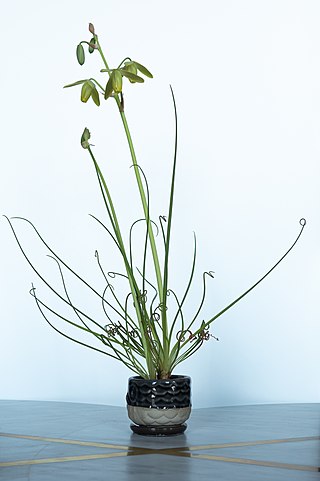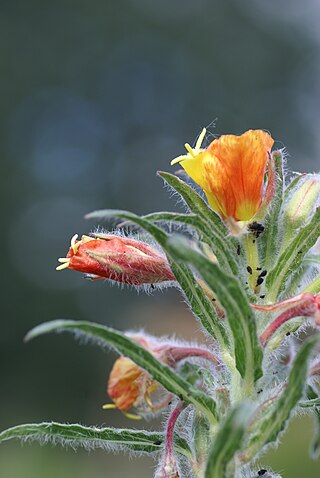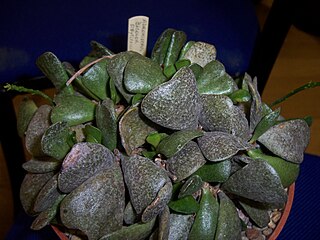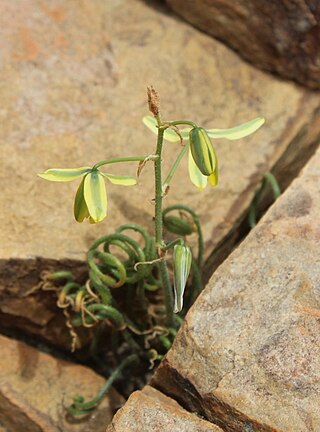
Albuca bracteata, is known by the common names pregnant onion, false sea onion, and sea-onion. It is a species of bulbous flowering plant in the family Asparagaceae. Its flowering stems can reach a height of 90 cm and can carry up to 100 greenish white flowers.

Calochortus amabilis is a species of the genus Calochortus in the family Liliaceae. It is also known by the common names Diogenes' lantern, yellow globe-tulip, golden globe-tulip, yellow globe lily, golden fairy lantern, golden lily-bell, Chinese lantern, and short lily.

Helminthotheca echioides, known as bristlyoxtongue, is a sprawling annual or biennial herb native to Europe and North Africa. It was originally placed within the genus Picris but is often separated within the small genus Helminthotheca alongside a few other plants which also have the distinctive outer row of bracts around the flowerheads. It is a ruderal plant, found on waste ground and agricultural soils around the world, and in some places it is considered a troublesome weed.

Albuca is a genus of flowering plants in the family Asparagaceae, subfamily Scilloideae. The genus is distributed mainly in southern and eastern Africa, with some species occurring in northern Africa and the Arabian Peninsula. Plants of the genus are known commonly as slime lilies.

Oxalis glabra is a member of the wood-sorrel family, Oxalidaceae. It is only one of the 800 total species belonging to this family. The plant is commonly known as finger-leaf due to its trifoliate leaf structure. This trifoliate structure can be seen in variations throughout all members of the genus Oxalis. However, the particularly narrow leaflets of the glabra plant look more like fingers rather than a common clover. The plant is native to South Africa and can be found carpeting the ground of woodlands and bushlands.

Albuca spiralis, commonly called the corkscrew albuca or frizzle sizzle, is a species of flowering plant in the family Asparagaceae, that is native to Western and Northern Cape Provinces, South Africa.

Romulea tortuosa is a herbaceous perennial geophyte in the family Iridaceae native to South Africa. It has a small corm in the soil, a few prostrate coiling leaves, and fragrant, trimerous yellow flowers, sometimes with six brown blotches on the inside near the bottom of the flower.

Mairia crenata is a perennial herbaceous plant of mostly 2–15 cm (1–6 in) high that is assigned to the family Asteraceae. It has a woody rootstock of up to 5 cm (2 in) long, from which brown, fleshy roots develop. The five to eighteen, hard and leathery, spoon-shaped leaves are in one to three rosettes, have a distinct main vein, blunt or pointy tip, often dark red or blackish margins with rounded teeth and a ½–2 cm (0.2–0.8 in) long stalk-like foot, often initially somewhat woolly hairy, on particularly the lower surface and the main vein, but this is easily rubbed off the shiny surfaces. Each rosette produces mostly one, sometimes up to four, mostly rusty or whitish woolly hairy, brown or dark red inflorescence stalks, usually 1½–15 cm long, each with two to eight, initially woolly, line-shaped to oval bracts, the lowest up to 3 cm (1.2 in), decreasing size further up, and carrying mostly one, rarely up to three flower heads. The flower heads have a bell-shaped involucre with about 40 bracts, sixteen to thirty three violet to white ray florets of about 1¼–1⅞ cm long, and many yellow disc florets. The species flowers anywhere between February and December but only after a fire has destroyed the overhead biomass or serious disturbance. It is an endemic species that is restricted to the Eastern Cape and Western Cape provinces of South Africa.

Mairia petiolata is a tufted, variably hairy, perennial plant of up to 15 cm (6 in) assigned to the family Asteraceae. Its leaves are in a ground rosette, and have a stalk of mostly 2–5 cm long and an inverted egg-shaped to elliptic, 61⁄2–9 cm (2.6–4.6 in) long and 2–3 cm wide leaf blade, with a toothed margin. It mostly has two flower heads at the tip of the branches of each erect, dark reddish brown scape. The flower heads have a bell- to cup-shaped involucre that consists of 20–24, purplish, overlapping bracts in 3–4 whorls. These protect 12–16 pink, ray florets, surrounding many yellow disc florets. This species was only seen flowering once, in December. It is known from one location in the Langeberg, Western Cape province of South Africa.

Drimia exuviata ("Gifbol") is a species of flowering plant in the family Asparagaceae, subfamily Scilloideae, indigenous to the south-western parts of South Africa.

Cyanella lutea is a species of cormous herb, native to South Africa and southern Namibia, where it grows in clay-rich or loamy soils.

Oenothera versicolor, the red evening-primrose, is a species of flowering plant in the family Onagraceae, native to South America, from Peru and Ecuador down to Bolivia and Northern Argentina This species is not as common in cultivation as other members of the genus but popular cultivars including 'Sunset Boulevard' are grown in gardens around the temperate world as the plant is hardy down to at least −10 °C (14 °F).

Ornithoglossum undulatum, also known as the Karoo Slangkop, is a species of flowering plant in the family Colchicaceae. It is found in Southern Namibia and South Africa. In South Africa its range extends as far east as Somerset East in Eastern Cape Province. O. undulatum is a poisonous plant, and consumption of the leaves can kill livestock.

Gazania pectinata, the cockscomb Gazania, is a species of flowering plant in the family Asteraceae, native to the lower-lying regions and coastal plains of the Western Cape Province, South Africa.

Gazania serrata is a species of flowering plant in the family Asteraceae, native to the Northern Cape and Western Cape provinces, South Africa.

Adromischus bicolor is a perennial, succulent plant in the family Crassulaceae. The species name bicolor refers to the light, grey-green leaves spotted with purple to purple-green spots. It is endemic to the Succulent Karoo of western South Africa, as well as the Eastern Cape, South Africa.

Albuca cooperi is a species of small, perennial, bulbous plant in the asparagus family.

Albuca acuminata is a species of small, perennial, bulbous plant in the asparagus family. It is native to southern Africa from Namibia to the Cape Province of South Africa, where it occurs in rocky areas, as far east as Port Alfred.

Albuca longipes is a species of small, perennial, bulbous plant in the asparagus family that is widespread across the western portion of southern Africa. It occurs throughout the winter-rainfall regime, from southern Namibia in the north, southwards as far as Cape Town, and eastwards as far as Willowmore.

Albuca viscosa, commonly called the sticky albuca, is a species of flowering plant in the family Asparagaceae, that is native to Western and Northern Cape Provinces, South Africa.
























